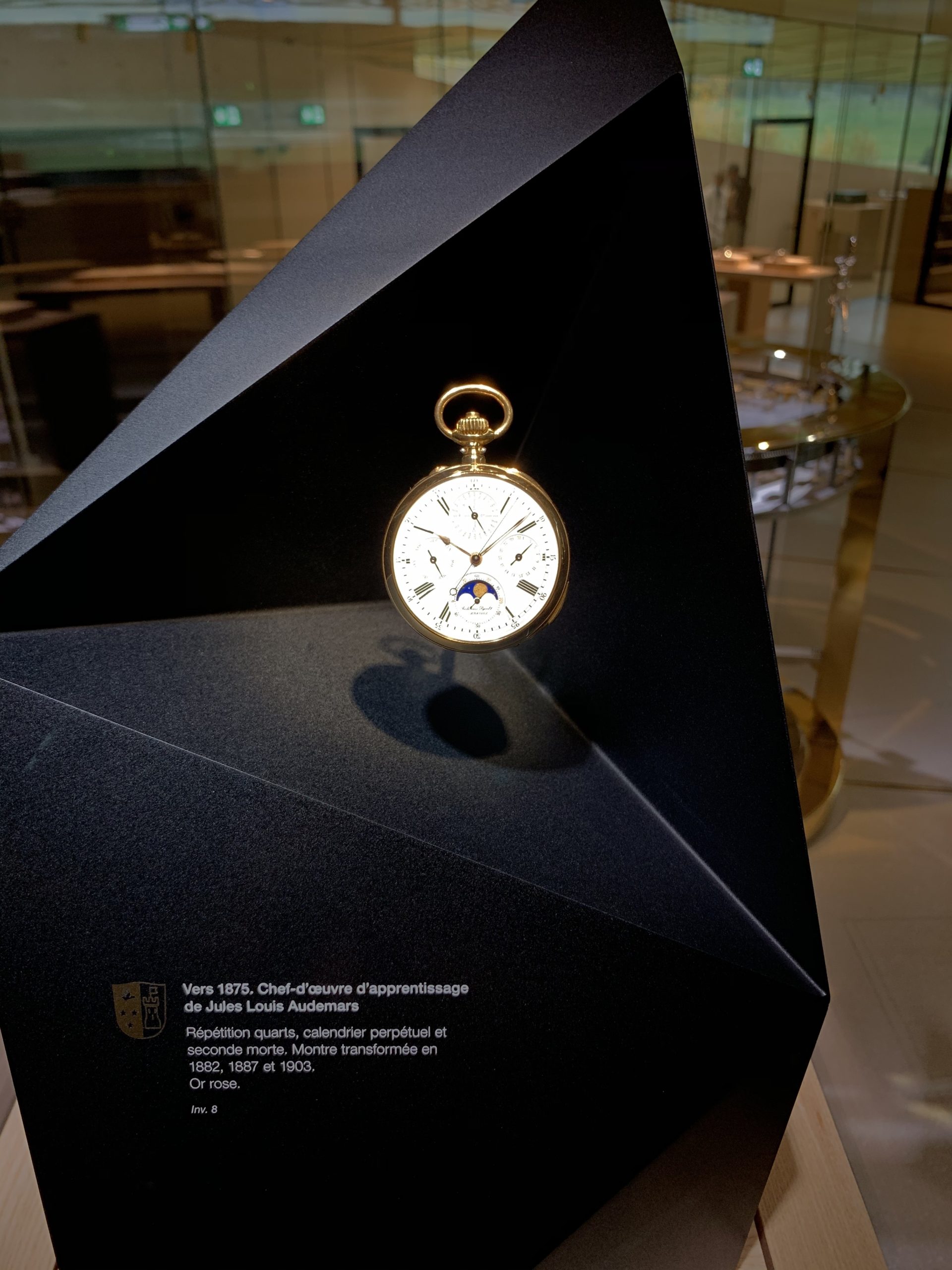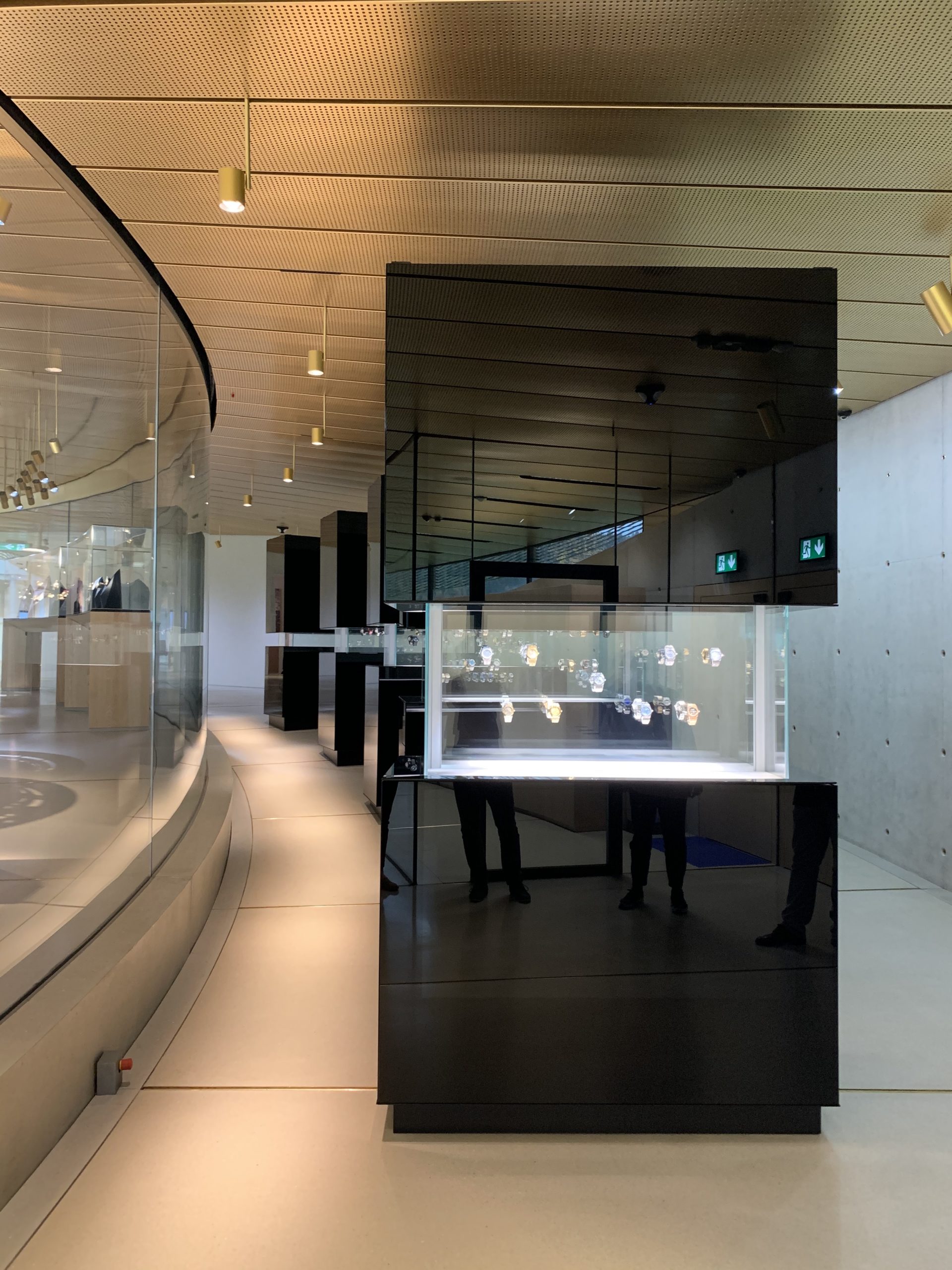Musée Atelier Audemars Piguet
A gem of an experience
SERVICE REVIEW
Author: Peter Horvath, Strategy & Service Design Lead at Whitespace
Date: 30 May 2022
Switzerland's newest watch museum tucked away in a mountain valley does a great job at communicating luxury in an accessible manner.
From its setting in the magical Vallée de Joux, to the building's architecture (designed by the Bjarke Ingels Group: BIG), to the visit itself – the Musée Atelier Audemars Piguet is a paragon of experience design and the subject of our most recent Service Review.
The Musée Atelier Audemars Piguet is a gem of an experience
A museum visit should not begin when you enter the door, should not end with exiting the building, and should not consist only of the exhibited items. The people at the iconic Swiss luxury watch brand, Audemars Piguet, knew this very well and created an engaging exhibit of luxury without making it pompous – communicating it through explicit attention to detail, and leaving only a few opportunities for improvement.
I'm not one of those people who spends time in the morning picking his watch for the day, nor do I scroll through watch magazines as the hours fly by. But I do appreciate craftsmanship and the heritage of watchmaking in Switzerland. Long story short, you don't need to be a watch buff to enjoy this museum.
1. Before the visit
Doing it differently
As a visitor, you normally pick a museum from a long list of museums in your city, go there, buy a ticket, and enjoy the visit. But when you are a watch brand with products costing north of $100'000, you need to be different. Instead of going grand, Audemars Piguet (AP from here on) chose the exact opposite, which fits them perfectly.
Naming and positioning
Creating luxury watches is a very hands-on affair, small scale in many aspects, e.g. sizes and quantity. That's part of the appeal. So AP didn't create a traditional museum. They created a Musée Atelier, which loosely translates as a working museum. Atelier means artist's workshop in French, the language of this region of Switzerland. The name itself signals that the experience awaiting you will be a tangible, intimate, private affair. Just what you'd expect from a brand like AP.
The private nature of the museum is further strengthened by the booking process. You don't just show up and buy a ticket. You book a guided tour online. When we visited in October 2020, we had to book weeks ahead. You can only book up to 2 of each ticket type, clearly showing this is not for large groups. There are no lines outside the door – this moment is reserved just for you and a few select others.
This anticipation speaks of exclusivity and becomes part of the experience. The challenge of getting in transforms the visit into an anticipated achievement.
Communication
The only thing slightly out of touch with this positioning was the communication. When opened, the museum's ads were all over Geneva, the nearest city. This mass-market channel strategy did not fit the museum at all but was probably chosen to drum up attention. Which again, is not a trait of exclusivity.
2. Arrival at the location
Getting there
The anticipation only grows as you approach the museum. In real estate, location is everything. And instead of placing the museum in one of the nearby cities, AP placed the museum right next to one of their historical sites, in the small village of Le Brassus in the Jura mountains. The way up there is winding, steep, and of course beautiful. The trip itself is an adventure. This links the before and during phases of your visit marvelously.
Wayfinding
When you arrive, the museum is not easy to find. While it's right next to their historic office building, there is no sign announcing the directions. And even when we were pointed in the right direction, the entrance was not obvious, and only a small sign announced the museum.
Entrance
Instead of a door handle, we were greeted by a camera and buzzer, without a name on it. A bit unsure, we rang, were welcomed, our names were asked, and only then were we let in. Once inside, you really do feel that you arrived. Your anticipation turns into a calm achievement.
The lounge
Remember that you are not in a traditional museum, but a Musée Atelier! That promise certainly manifests in the lounge area. You are seated on couches, with neatly arranged drinks, a large carpet, and shelves full of interesting items. It sparks a cozy atmosphere somewhere between a business meeting and a home visit - but certainly not a museum entrance hall. You keep your voice down automatically, and an appreciation of being welcomed forms naturally.
Meeting your guide
With only a few visitors per tour, 2 visits per day, and open only a few days open per week, the guided tour feels private. This is further strengthened by the fact that the guide is not a guide, but AP employees taking turns in showing the exhibit. This further strengthens authenticity, exclusivity, privacy, and welcoming.
You might think that exclusivity and being welcoming are contradictions. "Think different". Getting in was deliberately hard, but it was a test that you have passed. You are treated as an insider now. This is how seemingly contradictory concepts are merged.
The fact that so many tiny elements make up your experience even before the tour begins speaks volumes. Similar to how a watch as a product is more than the sum of its parts, this service is more than the visit itself.
3. The tour – beginning
The 2nd 'first impression'
The museum successfully challenges the adage that "you only get one chance to make a first impression". The lounge area was the first first impression. Entering the exhibition space is the second first impression. Guided through a massive old door, and down a narrow staircase, you are clearly led from the traditional to the modern. From the familiar into the unknown.
The wow factor
Things have been static so far, and after the solemn first impressions of the two lounges, it was time for something energizing. This came in the form of a rotating table. One side shows the valley where the factory and museum are located. The other side is a zoomed-out view, showing the region in its wider context of the Lake Geneva (the Léman) area.
The animation between the two states of the map is really cool and surprising - check out the spoiler below. And it is also a bit of l'art pour l'art. It's cool for coolness' sake. It also does not involve the visitor, as it is operated by the guide alone.
Spoiler
Hover (or tap) to reveal the map's transition

Telling a good story
How does watchmaking evolve in a small valley? What do rocks have to do with it? What does the weather have to do it? What does people's occupation have to do with it? All this is explained in a simple yet systemic story that shows how the circumstances of this place provided unique challenges, and thus a unique opportunity, for watchmaking to develop. I won't spoil the story - it's worth hearing first-hand.
A family tree
AP is not the only brand located in this small valley. Other brands such as Jaeger-LeCoultre, Breguet, or Blancpain are literally a stone's throw away. And since we are talking about a small town, these brands are all connected on a personal level through the generations. This complex web of interpersonal relationships is very nicely illustrated on a hand-crafted family tree that offers both a bird's eye view and an opportunity to explore in detail.
Showing the craft
The exhibit started with history and an image of the region, then zoomed in to the families and people involved, and by the third step arrives at products - some actual watches from the past centuries. This transition from vague to concrete, from theoretical to practical is a perfectly paced journey that keeps attention alive and allows visitors to always explore things from a new perspective.
4. The tour – the middle
Getting hands-on
By this point, the visitor will have felt the ambiance of the museum, heard a lot about history, seen the people and products. Felt, heard, seen. Three senses have been covered. And the museum creators were well aware that people also want to interact: to touch!
And the real magic of watches is in the movements (pun intended, for those who know) and complications. So this next part of the museum is the perfect time to introduce interactivity. Through a number of oversized watch pieces, guests are not just told about how a watch works, but are actually invited to explore up close.
Amaze
Now that visitors are aware of the underlying principles, it is getting harder to show something new. So in the next stage they bring out the big guns. Or rather, the small. It is in this part that the real craftsmanship is displayed, with mechanics so intricate and complex that even though you see them, it is hard to believe they can exist. This section of the exhibit is at the very center of the building - probably not by accident.
Amaze more – with less
By now you will be overwhelmed with complexity. So with a sudden twist, visitors are shown complexity in the simplest of manner. A small screw. No, not small. Not tiny. Miniscule. They literally had to place magnifying glasses around that screw to allow people to see it. Sometimes less is more.
Let them play
To this day, watchmaking is about hands-on, manual, precision work. At this next stage, visitors can now explore how difficult it is to make these watches. Several tools and little challenges are laid out on a large table, allowing you to try watchmaking yourself. I thought I was quite apt at handling tiny screws until one just disappeared from my hands. I hope someone found it before the vacuum cleaner did...
5. The tour – end
The finale
Average visitors like me will probably be overwhelmed by this point, and feel like they've seen everything. But as a grand finale, a series of elegant, obelisk-like display cases appear, revealing a final set of watches. While most of the exhibit was stationary, these moving obelisks nicely echoed the grand and surprising movement of the map table from the exhibit's first stage.
Bonus ending
But wait, there's more. The museum building itself echoes the precision, ingenuity, innovation, and respect for raw materials that characterize watchmaking. A final room had a very elegant display of the building's materials, along with a short movie and a well-crafted VR experience, showing the concepts behind the structure. While this is hosted in a small room, due to the small group sizes it allows complete exploration.
6. Summary
The Musée Atelier Audemars Piguet is a rich and comprehensive service experience. It creates a masterful mix of the senses and scales, materials and thoughts. It also crafts a memorable multi-modal customer journey. As mentioned, access is limited so be sure to book your visit ahead of time. You will not be disappointed.
While there are certainly opportunities to improve, the biggest gap is the missing after element of the experience. With little more to take home than your photos and memories, this might leave some visitors with a slightly empty feeling. But maybe this was intended all along, to show how ephemeral and aspirational luxury really is...
All opinions expressed throughout this article are the author’s own and do not necessarily represent those of Whitespace or its affiliates.



































